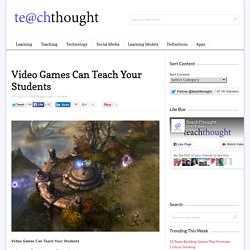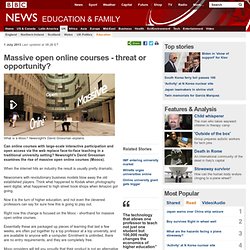

Video Games Can Teach Your Students. Video Games Can Teach Your Students by Andrew Ross, Language Teacher in Japan Ed note: The post below is part 1 in a 3-part series on the reality of teaching with video games.

Learning a new language isn’t easy. I know. I live in Japan but I still can’t speak Japanese very well. Instead, students are taught to translate so they can understand. This applies to the US as well. 4 Key Benefits To Using Open Source In Education. In 2012, most of the pedagogical and technological community were taken by storm from a report by One Laptop Per Child (OLPC) that laptops dropped off in rural Ethiopia had been learned from in ways the contributors never imagined.

Not only did the children who received the laptops, many of whom were pre-literate and had no prior exposure to digital technology, make use of the programs the developers uploaded, they began to hack the Android-based operating system that the laptops used, reenabling the webcam and modifying the laptop desktops—an application that was previously blocked by the developers working on the specialized laptops. This anecdote is one of many that indicates that children and technology do, indeed, play well together. I would argue that not only does technology have to be further integrated in the classroom, it also should come from a certain source—open source. What Are The Biggest Online Learning Trends And Challenges? What is the future of technology in education? A couple of weeks ago I was asked what I thought the future of technology in education was.

It is a really interesting question and one that I am required to think about all the time. By its very nature, technology changes at a fast pace and making it accessible to pupils, teachers and other stakeholders is an ongoing challenge. So what is the future? Is it the iPad? No, I don't think it is. iPads and other mobile technology are the 'now'. The future is about access, anywhere learning and collaboration, both locally and globally. Untitled. Massive open online courses - threat or opportunity? 1 July 2013Last updated at 08:26 ET.

CrunchU: TechCrunch Partners With Udemy To Offer Online School. Everyone and their mother is jumping into the online learning space it seems. TechCrunch is no exception. They’ve just announced a partnership with Udemy to offer an online school for startups. It’s called CrunchU and is designed to offer skills in technology, development, raising money for startups, and web design.
So, basically a lot of the courses already available on Udemy but with a TechCrunch twist. New Survey Uncovers Big Trends In Online Learning. The role of online learning in education is a hot topic right now. But who is actually taking advantage of this service? Teachers? Students? Who is using it bolster their academic endeavors? What are current and former online students saying about the process? The HotChalk Education Index surveyed more than 25,000 students, teachers, parents, and tutors over a period of 90 days. The Past, Present, And Future Of MOOCs. 10 Ways To Become A Better Online Learner 11.31K Views 0 Likes There are some quick and easy ways to become a better online learner. Whether you're taking a class or just researching, here are the DOs and DON'Ts. 5 Tips For Hosting Online Class Discussions. Class discussions that can occur any time of day and students engaged in that discussion.

It took me a while to get my head around ‘online’ discussion and I used the experience of other teachers in my school who’d tried it. I currently use this with my Independent Directed Study students (Japanese language) and will be expanding it to my Year 4 students next year. What to consider? How Online Education Has Changed In 10 Years. Udemy Course: Making iPhone and iPad Apps in 1 Hour Without Programming. The Skills Both Online Students And Teachers Must Have. Decades after the Sloan Consortium funded the first large-scale online learning programs in the U.S., online learning has finally hit its stride. According to the 2012 Survey of Online Learning conducted by the Babson Survey Research Group, the number of students taking at least one online course has now surpassed 6.7 million, an increase of more than 570,000 students over the previous year.
Moreover, thirty-two percent of higher education students now take at least one course online. Yet despite this bullish growth, research shows that course completion and program retention rates are “generally lower” in online courses than in face-to-face courses. Non-traditional students – students 25 and older who return to school for any reason, including 2- or 4-year degrees, professional certification, workforce training or just continuing education – are most attracted to online learning because of the flexibility and “anytime, anywhere” style of instruction. 1. 1. 1.
About the Author Todd A. Courses. New MOOC 'Instreamia' Offers Language Learning With A Twist. Scott Rapp and Ryan Rapp are purveyors of a new twist in the MOOC trend, what I’m calling ‘’mini-MOOCs.’’ That is, a startup or professor launching an open online course intended for the masses on their own, without the help of a large university or consortium of universities. Scott, a former Spanish teacher turned computer data systems specialist, is teaching a free Spanish language MOOC course that started in January 2013.
It’s a way to test the concept of their Instreamia language-learning startup . The Rapp brothers are a team to watch in the ed tech space. In the Wild West of MOOCs, their experiment shows how some teachers and entrepreneurs see the trend as a way to either make a buck, test an idea, build an audience, market their product or all of the above. Scott was a data systems engineer at Deloitte & Touche consulting firm, where he helped Fortune 500 companies re-engineer their systems.